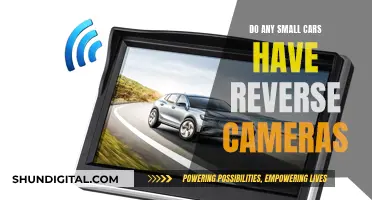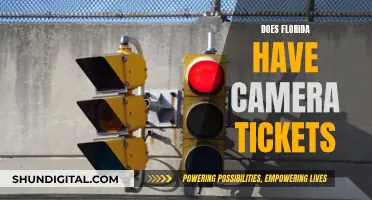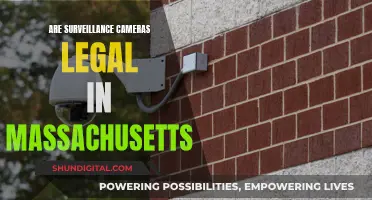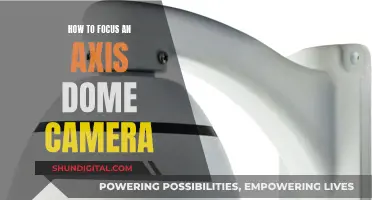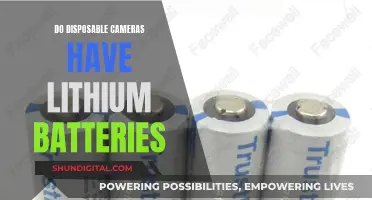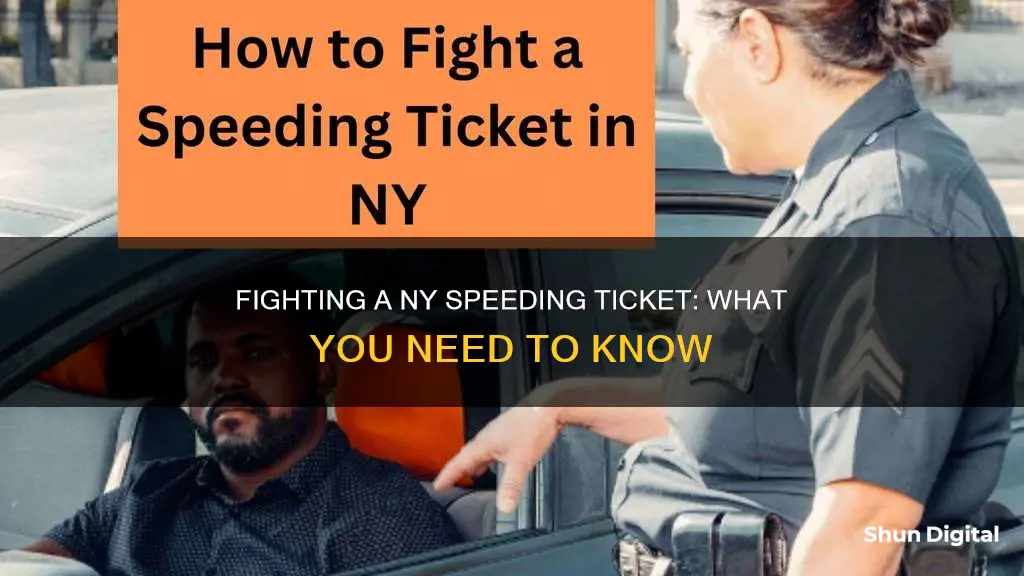
If you've received a speeding ticket from a camera in New York, you can dispute it online, by mail, via a mobile app, or in person. It's important to act quickly, as you must request a hearing within 30 days of the ticket being issued to avoid late penalties. Before disputing the ticket, it's a good idea to research common defences and gather any evidence that supports your dispute. You'll need to enter the 10-digit number on your camera violation Notice of Liability, and you may also need to provide your license plate information. You can also request a transcript of an in-person hearing for your appeal, although you'll need to pay for it.
| Characteristics | Values |
|---|---|
| Time to dispute ticket | Within 30 days of receiving the ticket |
| How to dispute ticket | Online, by mail, via the Pay or Dispute mobile app, or in-person |
| What to do if you miss the 30-day deadline | You will have to pay late penalties if found guilty |
| How to request a hearing transcript | Submit the online Request a Hearing Transcript form or mail a letter with relevant information to the New York City Department of Finance |
| Cost of the hearing transcript | You will be informed of the cost within seven business days of your request |
| Time to pay for the hearing transcript | You must pay within 10 business days of being informed of the cost |
| Where to send the mail | New York City Department of Finance Adjudications Division Parking Ticket Transcript Processing 66 John Street, 3rd Floor New York, NY 10038 |
| How to dispute a ticket in person | Visit a Department of Finance business center between 8:30 a.m. and 4:30 p.m. |
| What to do if you cannot conduct your hearing online, by mail, or via the app | Schedule an in-person hearing or visit a Department of Finance business center |
| What to do if you receive a ticket outside of New York City | Contact the local courts or the Department of Motor Vehicles Traffic Violations Bureau |
What You'll Learn

Plead not guilty by mail or online within 30 days
If you believe that you've been wrongly issued a speeding ticket by a camera in New York, you can plead not guilty and dispute the ticket by mail or online within 30 days of the issue date. Here's a step-by-step guide to help you through the process:
Step 1: Examine Your Ticket
Check the date, time, and location of the ticket. As camera tickets are sent to the owner of the car, verify that you were indeed driving the vehicle when the ticket was issued. Make sure to note the exact code section you're cited for violating and understand the associated law, including any penalties for violation. Review any photos included with the ticket to confirm that it's your car in the image and that the photo is clear.
Step 2: Plead Not Guilty by Mail or Online
To dispute a speeding ticket in New York, you must plead not guilty within the specified timeframe. You can do this either by mail or online. To plead not guilty by mail, send the ticket along with an explanation of your defence and any supporting evidence to the following address:
NYC Department of Finance, Hearing by Mail Unit, P.O. Box 29021, Brooklyn, NY 11202-9021
Written defences may be submitted in any language and will be translated by a certified translator.
To plead not guilty online, visit the Department of Finance's (DOF) parking or camera violation dispute website. Enter your email address to receive a link to the Dispute a Ticket website. Enter the 10-digit number on your camera violation Notice of Liability, fill out the online hearing request form, and upload any additional evidence to support your dispute.
Step 3: Prepare Your Defence
While waiting for your hearing, research applicable laws and defences. Look for cases in your city or county regarding traffic cameras and check if any appellate court decisions have ruled on the legality of traffic camera tickets. Also, research common defences and gather any necessary documents or evidence to support your case. Some possible defences include challenging the authenticity or admissibility of the photograph as hearsay, asserting your right to confront witnesses, or disputing the lack of warning signs for cameras before a traffic light.
Step 4: Attend the Hearing
Arrive at the hearing organised and well-prepared. Treat the judge and courthouse staff with respect, and present your case clearly and concisely. Provide any evidence or documentation that supports your defence. Remember that the prosecution has the burden of proving each element of your violation, so focus on highlighting any gaps or weaknesses in their case.
Charging Your GoPro: A Step-by-Step Guide
You may want to see also

Research common defences and evidence
Before disputing a ticket, it is important to research common defences and gather all the necessary documents to support your dispute.
Common Defences
- The speed limit sign was not clearly visible or was missing: If the speed limit sign was obstructed, not visible, or missing altogether, you may be able to argue that you were unaware of the speed limit.
- The speed limit changed suddenly: If the speed limit changed abruptly from a higher speed to a lower speed without adequate warning, you may argue that you did not have enough time to adjust your speed.
- You were speeding due to an emergency: If you were speeding to respond to an emergency situation, such as rushing someone to the hospital, this may be considered a justifiable reason.
- The radar or camera equipment was faulty or not calibrated correctly: You can request the calibration records of the equipment to verify its accuracy.
- You were speeding to keep up with the flow of traffic: While this is not a valid legal defence, it may be used as part of a broader argument.
Evidence
- Photos or videos of the location: These can provide valuable context and support your claim, especially if there are issues with signage or road markings.
- Calibration records of the radar or camera equipment: You can request these records to verify that the equipment was functioning properly and had been calibrated recently.
- Witness statements: If there were passengers in your vehicle or other witnesses who can attest to the circumstances, their statements can support your defence.
- Maintenance records of your vehicle: If you were speeding due to a mechanical issue, such as faulty brakes, these records can help demonstrate that it was beyond your control.
- Documentation of speed limit signs: If the speed limit signs were unclear, improperly placed, or missing, documentation or photos of their placement can support your claim.
Finding the Camaro's Battery: Fifth Generation
You may want to see also

Submit evidence and attend a hearing
If you wish to dispute a speeding ticket in New York, you must request a hearing within 30 days of the ticket being issued. You can do this online, by mail, via a mobile app, or in person. Hearings can be conducted online, by mail, via the app, or in person.
To submit evidence, you will need to provide the 10-digit number on your camera violation Notice of Liability, fill out the online hearing request form, and upload any additional evidence. You can also do this via the mobile app, where you can add images or video evidence, or by mail, where you should include an explanation of your defence and copies of any supporting evidence.
If you are submitting evidence in person, you must bring your driver's license, vehicle registration, and any evidence to support your dispute. An administrative law judge will make a decision based on the evidence presented and issue a ruling at the end of the hearing.
It is important to note that all statements, information, and documents submitted must be true and accurate to the best of your knowledge. Providing false statements or evidence may result in penalties.
Unleashing Panasonic's Burst Mode: Capturing Action with Precision
You may want to see also

Challenge the admissibility of the photo as hearsay
If you've received a speeding ticket in New York, you can dispute it online, by mobile app, by mail, or in person within 30 days of receiving the ticket. If you fail to dispute it within 30 days, you will incur a late penalty.
Now, if you decide to dispute a speeding ticket in New York, one strategy is to challenge the admissibility of the photo as hearsay. Hearsay is a statement made by someone outside of court that a witness repeats while testifying in court. The legal system wants witnesses who have something to say to be in court so that lawyers can cross-examine them, and juries can assess their honesty, possible mistakes, and potential bias.
In the context of a speeding ticket, challenging the admissibility of the photo as hearsay would involve arguing that the photo of your car exceeding the speed limit is secondhand information that hasn't been subject to cross-examination. You could argue that the photo is not reliable evidence because it hasn't been properly scrutinized or that the process of taking and presenting the photo may have involved errors or biases.
However, it's important to note that even if you challenge the photo as hearsay, there may be exceptions that allow its admission. For example, if the photo is part of an official record, it may be considered reliable and admissible. Additionally, the other party may argue that the photo is not being offered for the truth of its contents (i.e., to prove you were speeding), but for another purpose, such as showing the location of the incident or the presence of your vehicle in a particular area.
To effectively challenge the admissibility of the photo as hearsay, it's recommended to consult with a lawyer who can review the specifics of your case and provide tailored advice. They can help you understand the applicable laws, exceptions, and strategies for disputing your speeding ticket.
Camera Tickets in LA: Do You Have to Pay?
You may want to see also

Raise other defences, e.g. necessity
The necessity defence is a legal argument that a person committed what would normally be a criminal act but that the circumstances justified their actions. In other words, it is a defence based on the "lesser of two evils".
To establish a necessity defence, a defendant must prove the following:
- A specific threat of significant, imminent danger existed.
- The situation required an immediate necessity to act.
- No effective legal alternatives were available.
- The defendant didn't cause or contribute to the threat.
- The defendant acted out of necessity at all times.
- The harm caused wasn't greater than the harm prevented.
For example, a defendant was convicted of driving with a suspended license as he had to travel to a telephone to call for help for his pregnant wife. The court ruled that the defendant should have been allowed to present a necessity defence.
If you are facing a speeding ticket in New York, you can dispute it online, by mobile app, by mail, or in person within 30 days of receiving the ticket.
Troubleshooting Camera Raw Command Issues
You may want to see also
Frequently asked questions
You must dispute a speeding ticket within 30 days of receiving it to avoid late penalties.
You can dispute a speeding ticket online, by mail, via a mobile app, or in person.
If you do not dispute your speeding ticket within 30 days, you will have to pay late penalties if an administrative law judge finds you guilty.
If you want to dispute a speeding ticket in person, you can visit a Department of Finance business center between 8:30 a.m. and 4:30 p.m., Monday through Friday. Bring your driver's license, vehicle registration, and any evidence supporting your dispute.


